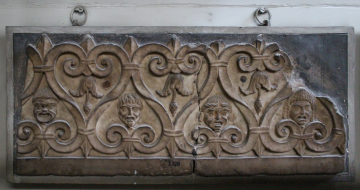Explore Collections


You are here:
CollectionsOnline
/
Fragment of a Roman decorative frieze
Browse
Fragment of a Roman decorative frieze
27 BC-14 AD
Augustan
Augustan
Italian marble
Height: 30cm
Width: 70cm
Width: 70cm
Museum number: M1278
On display: Drawing Office - also known as the Students Room (pre-booked tours only)
All spaces are in No. 13 Lincoln's Inn Fields unless identified as in No. 12, Soane's first house.
For tours https://www.soane.org/your-visit
Curatorial note
The elaborate carving on this piece comprises linked scrolls above which project palm-leaf tips; within the upper interior spaces are reversed acanthus flowers and, in the lower, alternate tragic, comic, Satyr, and other masks.
The motive - centred on linked lyre patterns - is another example of early Roman imperial or imperatorial architectural decoration in marble derived from later Roman Republican and Italian terracotta forms1. In the marble carving of the Augustan age the enrichment exemplified by this fragment develops into the type of delicately carved honeysuckle, palmette and mask frieze or enriched panelling found in a building near the Titurna in the Roman Forum (preserved in situ) and elsewhere throughout Rome2. The motive or compositional impetus continues in Roman art until it merges with the figured scroll, an Asiatic Hellenistic development, and becomes the elaborate carving of foliate masks in the lower moulding entablature of the main pylons of the Arch of Septimus Severus in the Forum3.
Here we see the conventional scrolled acanthus frieze formed at regular intervals into bearded acanthus masks.
1 Compare for example, A. Andrén, Architectural Terracottas, Archaic Terracottas, p. 364 f., pl. 109, no. 389, from the Via dell'Impero; early fifth century BC openwork cresting from Segni, pl. 121, no. 428; 2nd-1st century BC cornice fragments from the same locale, pl. 124, no. 438; 4th-3rd century BC revetment fragments from Lanuvium (modern Lanuvia), pl. 132, no. 459, and, from the period of rebuilding in marble, a first century BC cresting from the last site, p. 133, no. 468.
2 Pietro Romanelli, The Roman Forum, (translated by M. Reid), 1983, p. 39; P. Gusman, L'Art décoratif de Rome de la fin de la république au IV siècle, 2 vols, Paris, 1910 , II, pl. 90.
3 L. Canina, Gli Edifizj di Roma antica, cogniti per alcune importanti reliquie,descritti e dimostrati nell'intera loro architettura, Rome, 1848-51, vol. IV, pl. CCLII.
The motive - centred on linked lyre patterns - is another example of early Roman imperial or imperatorial architectural decoration in marble derived from later Roman Republican and Italian terracotta forms1. In the marble carving of the Augustan age the enrichment exemplified by this fragment develops into the type of delicately carved honeysuckle, palmette and mask frieze or enriched panelling found in a building near the Titurna in the Roman Forum (preserved in situ) and elsewhere throughout Rome2. The motive or compositional impetus continues in Roman art until it merges with the figured scroll, an Asiatic Hellenistic development, and becomes the elaborate carving of foliate masks in the lower moulding entablature of the main pylons of the Arch of Septimus Severus in the Forum3.
Here we see the conventional scrolled acanthus frieze formed at regular intervals into bearded acanthus masks.
1 Compare for example, A. Andrén, Architectural Terracottas, Archaic Terracottas, p. 364 f., pl. 109, no. 389, from the Via dell'Impero; early fifth century BC openwork cresting from Segni, pl. 121, no. 428; 2nd-1st century BC cornice fragments from the same locale, pl. 124, no. 438; 4th-3rd century BC revetment fragments from Lanuvium (modern Lanuvia), pl. 132, no. 459, and, from the period of rebuilding in marble, a first century BC cresting from the last site, p. 133, no. 468.
2 Pietro Romanelli, The Roman Forum, (translated by M. Reid), 1983, p. 39; P. Gusman, L'Art décoratif de Rome de la fin de la république au IV siècle, 2 vols, Paris, 1910 , II, pl. 90.
3 L. Canina, Gli Edifizj di Roma antica, cogniti per alcune importanti reliquie,descritti e dimostrati nell'intera loro architettura, Rome, 1848-51, vol. IV, pl. CCLII.
Rome; collected by Charles Heathcote Tatham for the architect Henry Holland during the 1790s. See Cornelius Vermeule, unpublished catalogue of the Antiquities at Sir John Soane's Museum, Introduction, transcription of Tatham letters, List 1, no. 27.
Literature
Tatham: Drawings, 13.
Soane collections online is being continually updated. If you wish to find out more or if you have any further information about this object please contact us: worksofart@soane.org.uk


